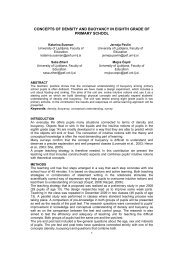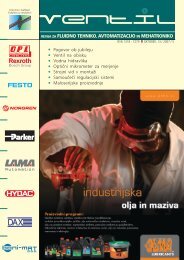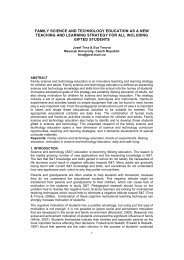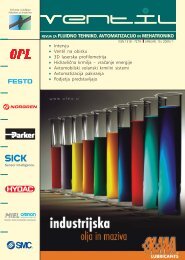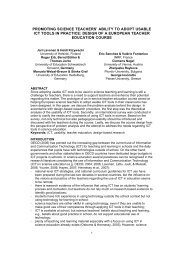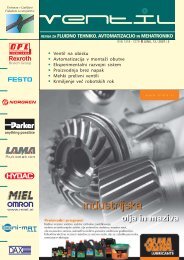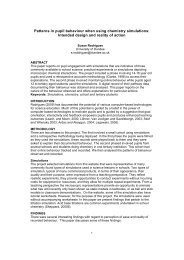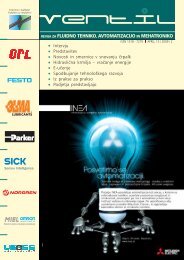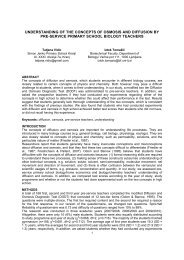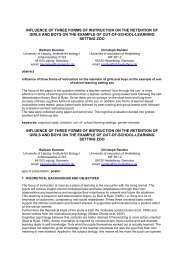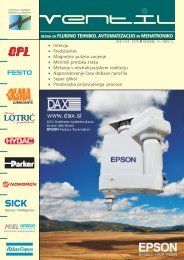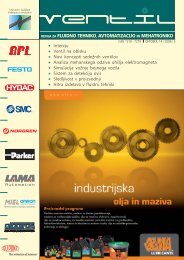1. PDF dokument (13 MB) - dLib.si
1. PDF dokument (13 MB) - dLib.si
1. PDF dokument (13 MB) - dLib.si
- No tags were found...
You also want an ePaper? Increase the reach of your titles
YUMPU automatically turns print PDFs into web optimized ePapers that Google loves.
DISKRETNA SIMULACIJAwith other modelons. A modeloncan con<strong>si</strong>st of other modelons andit can be a part of a modelon – likeobjects in object oriented programming.A modelon structure is used todescribe part-system, entity-wholerelations, interaction and cooperationof building blocks and self-reflexiverespon<strong>si</strong>bilities. Structuring system<strong>si</strong>nto modelons and relations amongthem provides the means to model,understand and de<strong>si</strong>gn complexhierarchies of deci<strong>si</strong>on-making processesfor control.One example of implementation ofa bionic distributed control systemcon<strong>si</strong>sts of machines and AutomatedGuided Vehicles (AGVs). The exampleis proposed and annotated on atheoretical level and it is evaluatedby discrete event type <strong>si</strong>mulation inthis contribution. Modelons of part<strong>si</strong>n production, and modelons ofmachines and AGVs correlate theiractivities for the success of the whole,which is optimized production.2 The product as a controlactor in FMSLet us remember that the problem ofmanufacturing control is in the clas<strong>si</strong>calapproach typically approachedby planning (level of production system)and by scheduling (productionfloor level). The problem is posedin terms of production flow and ofresource allocation. The outcome ofthese steps is clas<strong>si</strong>cally a Gantt chartthat freezes the operations allocatedto each resource, as a function oftime. It can be said for this approachthat it is mostly based on workwith manufacturing operations. It ischaracterized by giving answers tothree questions that are, in order:Which resource does the operation?– When does the operation take place?– What product is concerned bythe operation? [6].The product approach (PA) [7], aimsat higher flexibility and reactivity. Inthis context a product may representan elementary component, an assemblyof several elementary componentsor a set of <strong>si</strong>milar components. PAisbased on a society model. Membersof this model are both, products andVentil 14 /2008/ 3resources. This approach leads torearranging the order of the questionsto: What product? Which resource?and When?The product becomes an active elementof the production system andtakes part in the deci<strong>si</strong>on makingprocess which defines its’ furtherproduction. Each product communicatesand negotiates with all theresources to make appointments foreach operation. The products arelike customers and the resources areservice providers. As a result, the productionsystem is made up of a set ofautonomous members, i.e., productsand resources, and they cooperate toachieve their goals. Agent structurescan be a method to implement sucha system.A fundamental question of the applicabilityof this reasoning is thefollowing one: if each member of thesystem optimizes his behavior for hisbenefits, how does that correlate tothe benefit of the whole?The question might seem trivial – atleast it is not that much addressedin the technical literature. Based onthe fact, one might conclude, thatthe skepticism is not justified. Onthe other hand, our approach tomanufacturing imitates principlesfrom animal and human world.Does such organization (group oflocal optimizations equals to globaloptimization) work for animals andhumans? Regarding former, it look<strong>si</strong>t works for highly organized species,as bees are. It is just we do not knowmuch, what kind of reasoning do theycarry in their genes and pass on fromgeneration to generation.Regarding humans, history and dailylife give us pro and contra exampleson individual vs. collective optimization.Principles of democracy seemto correlate benefits of individualsand benefits of society the most. Butprinciples of democracy involve lotsof con<strong>si</strong>deration and empathy, whichdon’t promise much as mechanismsof optimization in manufacturing.Be<strong>si</strong>des, many activities of humanindividuals are optimized for theirindividual well being (wild privatization,taikunization, shattering financialmarkets by intention), but theyare catastrophic for the society. Theseexamples convince us in relevanceof questioning one to one mappingbetween individual and collectivewell being. However, a general po<strong>si</strong>tivecorrelation between the two cannot be overseen. It convinces us thatthe socio approach to manufacturingis worth of exploration. Especially,<strong>si</strong>nce it is the de<strong>si</strong>gner of a manufacturingsystem, who plays God whende<strong>si</strong>gning a control system. He hasfree will to decide, what to take fromthe fields of sociology and psychology,and what to take not. One way toevaluate correlation between individualreasoning and its’ benefit to theoverall system is <strong>si</strong>mulation.2.1 Implementation of PAPrinciples of PA associate all theknowledge and all the deci<strong>si</strong>on capacitythat are required for productioncontrol. As a result, the productpossesses the specific knowledge tosearch for and to process informationon the production process: productiongoals, deci<strong>si</strong>on rules, equipmentfeatures and production environment[8]. This specific knowledgebase contains all information on theproduct, as it passes phases of theproduction process, including:– its identity, its functional and structuralfeatures, its parameters,– the process and the operational sequenceto produce the product,– the priority weights,– the equipment features and productionenvironment.Products’ knowledge base also contain<strong>si</strong>nformation on the prearrangedschedule, on the up-to-the-timestate of advancement and quality ofperformed operations, on productiongoals and deci<strong>si</strong>on rules. This informationor knowledge is used to findout a heuristic solution to achievethe planned objectives, taking intoaccount the unexpected events. Regardingbehavior of resources, theyare autonomous, as products are.Resources have a specific knowledgebase containing required informationto perform operations.245



